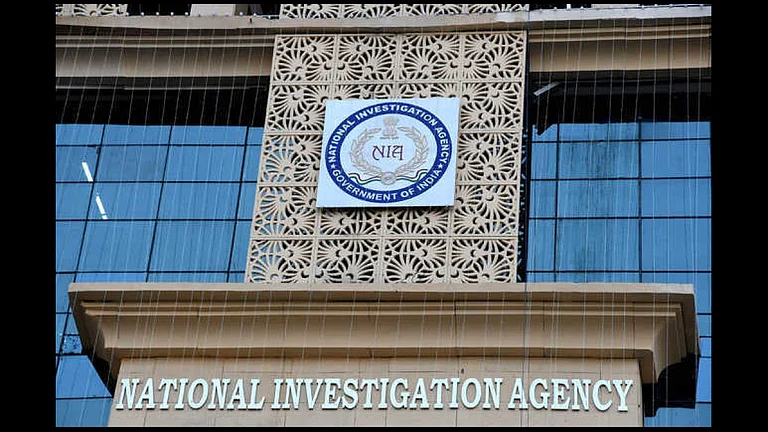In the movie The Kashmir Files, Krishna Pandit is an impressionable young Kashmiri Brahmin whose family has been slaughtered by Muslim militants. But because he was too young when the killings took place, he does not remember the episode.
As an adult, when he joins a premier university in New Delhi, Krishna finds himself chaperoned into a fellowship of leftists. They are all characteristically dismissive of the stories of the suffering of Hindus in Kashmir.
At first, he appears to be yielding to their persuasions. But thankfully, the wise words of his sage grandfather prevail and help Krishna steer clear of this treacherous path.
At a grand college event, Krishna thus narrates his epiphanous encounter with the “truth”. He begins with a rendition of Kashmir’s “neglected” history.
“Do you know who Shamsuddin Araqi was? No?” he asks smugly, clucking in disapproval. “You study in the topmost university in India but don’t know about Araqi?”
Then, he proceeds to describe him. “Several thousand times more ferocious than (Adolf) Hitler, Araqi was an Islamic tyrant whose only motive was to tear down the temples of infidels in Kashmir,” he thunders at a surprised audience.
He enumerates the crimes Araqi committed against Kashmiri Brahmins, including forceful feeding of beef and circumcision so that they are effectively converted into their new religion, Islam.
To bear out his revelations, Krishna quotes from Tuhfat-al-Ahbab, Araqi’s biography, which is rife with the boastful descriptions of this savagery. “If you want the original manuscript, it’s available in the Research and Publication Department of J&K State under extraction number 551,” he says.
The movie has sparked a barrage of discussions in India, some favourable, others critical.
But what has received scant attention is how the makers harness disparate elements of Kashmir’s history to reiterate and reinforce old and long-running legends about the region – some of which effectively turn the history upside down.
Shamsuddin Araqi was a 12th century Sufi saint known for popularising Shia Islam in Kashmir. However, the portrait that historians sketch of Araqi is at odds with characterisations casting him as uniquely bigoted and villainous.
To help demystify the region’s vexed history and shed light on the role played by Araqi, Outlook spoke to Dean Accardi, Assistant Professor of History at Connecticut College who specialises in Kashmir’s medieval history.
What do you think about Shamsuddin Araqi’s characterisation as an ‘Islamic tyrant’ who persecuted Hindus in Kashmir?
First of all, historical manuscripts are not consistent in spelling. He is referred to as Iraqi, Araqi or Araki depending on where you look. Second, Araqi and his followers definitely persecuted non-Muslims in Kashmir. Their own hagiographies (stories and histories of saints and religious leaders’ lives and exploits) outright brag about it.
The Nurbakhshi Sufi followers of Shamsuddin Araqi, in their own sources, claim they persecute non-Muslim Kashmiris because they are infidels and idol worshippers and because they think some non-Muslims are trying to pass as Muslims, which they find abhorrent.
But a closer historical analysis seems to indicate that the reasons they give for persecuting non-Muslims are just a cover to make it seem like their behaviour is righteous and pious.
Instead, Araqi and his followers’ true motivation for violence against non-Muslims was a struggle for political power against the other predominant Muslim groups in the Valley.
At the time, the Kubrawi, Suhrawardi, and Rishi Sufi tariqahs or Orders – prominent members of which were Ali Hamadani, Hamza Makhdum Sahib, and Nund Rishi respectively – were close religious and political allies with each other and with non-Muslims and had large factions of Kashmiri nobles and even sultans in the royal court as their patrons.
Thus, the Nurbakhshis – who is a Shia-affiliated offshoot of the Kubrawi Order that claims to be the true heirs of Ali Hamadani and their founder Muhammad "Nurbakhsh" Qahistani a messiah figure – had no way of gaining a foothold in Kashmiri religious institutions, let alone political patronage, unless they were able to battle with, break the power of, discredit, and poach followers from the Kubrawi-Suhrawardi-Rishi-Non-Muslim coalition.
Thus, they got to work, at first hiding that they were not Kubrawis but implied they were merely a separate Kubrawi lineage to gain power and positions of authority in Kubrawi shrines, khanqahs (hospices), and masjids. Then they began defaming and openly arguing against those Muslims who supported the poet Jami and other anti-Nurbakhshi scholars. Then they began attacking, beating and destroying the property of Muslims who did not agree with them.

What kind of a person was Shamsuddin Araqi and what sparked his journey to Kashmir?
Shams al-din Araqi was an ambitious and persistent man. He was a devotee of the Nurbakhshi Order, but not among Nurbakhsh's chief disciples. He made great efforts to obtain a position in the court of the Timurid Sultan Hussain Bayqara and then strove to be given an important task as a representative of the court abroad, to which the Sultan eventually conceded and sent Araqi to Kashmir as an emissary to make diplomatic contact.
However, upon entering Kashmir, he dropped his role as emissary (except when needed to get himself out of trouble with the court), and instead he took up a mission to convert Kashmiris to the Shia-affiliated Nurbakhshi Order and tie it to exclusive royal patronage.
However, when he arrived in Kashmir, the prominent Kubrawi Sufi master Sheikh Ismail was the chief attendant in charge of Ali Hamadani's Khanqah-i-Moula (a hermitage turned Sufi shrine in Srinagar once associated with political power) as well as the Sheikh al-Islam, the top religious authority as designated by the Sultan.
Sheikh Ismail was suspicious of Araqi and considered him a dangerous charlatan. So Araqi bided his time, ingratiating himself to Ismail's disciple Baba Ali Najar as well as some ambitious nobles currently out of favor with the royal court.
When Sheikh Ismail neared his death, he made Baba Ali Najar his deputy and passed custodianship of the Khanqah-i-Moula to him. Araqi saw his opportunity before him; he convinced Baba Ali Najar to pass custodianship of the Khanqah-i-Moula over to Araqi himself and then convinced the Kashmiri noble Malik Kaji Chak to demolish the shrine so that it could be rebuilt as a larger, two-story structure.
However, after demolishing it, the rebuilding was postponed, providing time for new Nurbakhshi shrines to be built, with Araqi and his followers promoting themselves as the true heirs of Ali Hamadani, and these new sites as the places to venerate him.
However, all the while Araqi seemed to bear a disdain for Kashmiris, seeing the Persianate culture of the Timurid courts where he came from as vastly superior, its people more learned, and its Shia religion truer.
Thus, whenever he encountered those who took pride in Kashmiri culture, dress, food, literature, etc. or were fervently Sunni, he would push them to see the superiority of Persianate culture and Shia religiosity, especially Nurbakhshi teachings and practices.

But if they remained obstinate in their Sunni religiosity or Kashmiri culture, he would treat them with condescending disgust or even respond violently.
With this attitude in mind, Araqi and his followers likely viewed the non-Muslim Kashmiri community as the strongest representation of Kashmiri recalcitrance to his missionizing activities—those most obstinately refusing to see the superiority of the Persianate Shia Nurbakhshi life and clinging to their traditional ways in defiance.
Thus, non-Muslim Kashmiris or Kashmiri Pandits were often those who took the brunt of Araqi and his followers' most violent actions.
Kashmir’s transition into the Sultanate period is often presented as an open-and-shut case of political change brought by relentless persecution and forced conversions. Is that exactly what happened or is there more complexity and nuance to the subject?
Kashmir's transition into the Sultanate period is the exact opposite of that. In fact, it is not even a case of Muslim conquest. Instead, during the late 13th and early 14th centuries, Kashmir was witnessing a political upheaval with Hindu nobles actively fighting each other for the rulership over Kashmir.
Amidst this political infighting, in 1320 CE, the Chaghtai general Zulju (Dulchu) and his troops invaded and raided the Valley via the difficult Zoji La pass. A number of Kashmiri nobles fled or were killed.
The Lohara Raja Ramachandra invited the Ladakhi Buddhist prince Rinchana to aid in his efforts to repel Zulju and seize the throne of Kashmir. In the end, though, it was Rinchana himself who successfully took the rulership over Kashmir.
However, despite marrying Kota Rani of the previous royal family ruling over Kashmir, it is said that numerous ministers of the court and other nobles refused to accept him as maharaja due to his caste being unknown due to him being a Buddhist.
Whether or not this is truly why they rejected Rinchana’s rule, when a prominent Suhrawardi Sufi Sheikh Sharaf al-Din Bulbul Shah came through Kashmir, Rinchana took his visit as an opportunity to quell dissent within the royal court's ranks by converting to Islam at Bulbul Shah's hands—simultaneously changing the basis for legitimate rulership away from one's caste identity, providing him with an excuse to elevate Muslim courtiers above those refusing to accept his rule, and potentially currying favour with Muslim rulers in neighbouring kingdoms.
Thus, the first sultan of the Kashmiri Sultanate was not a foreign Muslim conqueror, but a Ladakhi Buddhist prince who converted to Islam.
There are scholars such as Henny Sender who have offered powerful commentary about Kashmir’s medieval history. They contest the notion that the pre-Islamic period of Kashmir was a communal idyll devoid of the violence that Muslims brought with them. In fact, she calls such an idea a “sign of Hindu revivalist sentiment of the late 19th century rather than an accurate representation of history.” Would you like to expand a bit on that?
No period of history in Kashmir was an “idyll devoid of violence.” Some wish to idealize the period of the Kashmiri Sultanate as some "Golden Age" whereas others would say the same about the 8th-10th c. Kashmir. But even the Rajataranginis refute that assertion, showing nearly every period of the past as involving intrigue, upheaval, and unrest in one way or another.
Claiming a "Golden Age'' in the past is almost always a means to try and promote and legitimise rulership in the present. Thus, in the 19th century, the Dogra Princely State of Jammu and Kashmir promoted pre-Sultanate Kashmir as an ideal age and as the "true heritage" of Kashmir in order to justify their rulership beyond the fact that the Dogras bought that rule from the British after the First Anglo-Sikh War.
The Dogras even created and heavily funded the Research and Publications Department in order to publish books from medieval Kashmir to promote a Hindu identity for Kashmir and emphasise a Hindu past while erasing Muslim contributions to Kashmiri history, learning, literature, culture, etc.
Even Orientalists like Aurel Stein and George Grierson were utilized by the court to further these ends and justify the Dogra Princely State's subjugation of the majority Muslim population of Kashmir over which it ruled.
(Shakir Mir is an independent journalist based in Srinagar)





















